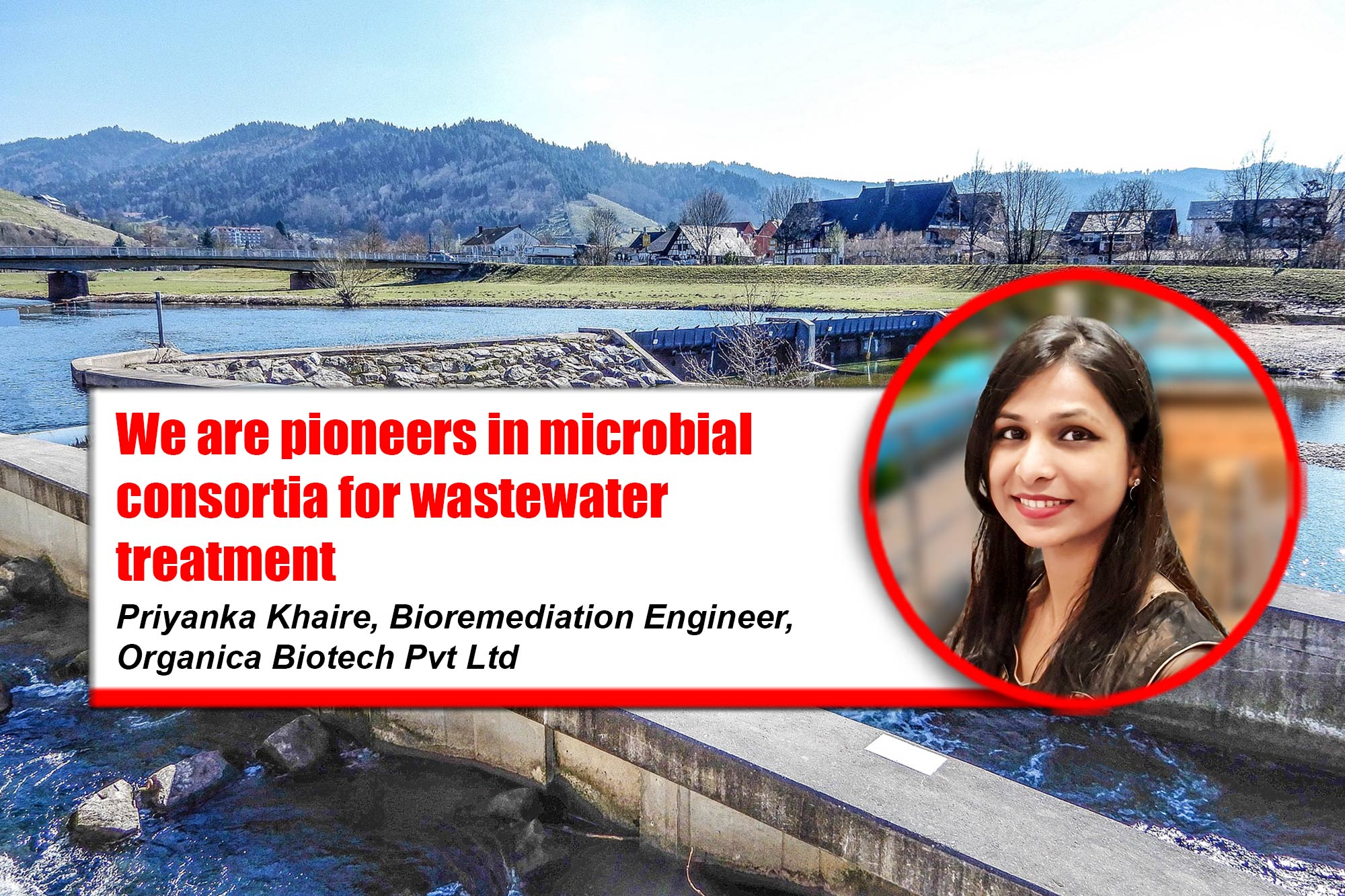We are pioneers in developing various microbial consortia for wastewater treatment
By Edit Team | August 11, 2020 8:34 am SHARE

Organica Biotech’s DSRI approved lab has a bank of more than 3,000 microbial strains which has helped us develop new and unique microbial formulations says Priyanka Khaire, Bioremediation Engineer at Organica Biotech Pvt Ltd.
When it comes to industrial wastewater treatment, is the process selection based on the type of industry in question?
Chemical, pharmaceutical, fertilizer, tanneries and related industries produce large amounts of wastewater in their production and cleaning processes. The characteristics of these effluents are often diverse. They may include toxic substances, minimally biodegradable matter or combination of both. To protect the environment, this wastewater typically must be treated to minimize the concentration of pollutants before discharging it in the environment, or to common effluent treatment plants for further treatment.
There exist various treatment methods like physical, chemical and biological. Compared to chemical and physical treatment methods, biological treatment processes prove to be very efficient when the wastewater contains biodegradable pollutants. Every biological process has its advantages and disadvantages. In practice, the selection of the most appropriate process needs to consider both technical and economical factors. Technically, the appropriate process is determined according to the wastewater characteristics, discharge requirements, available plant space and allocated budget.
The diversity of process water within the chemical, pharmaceutical and other industries is enormous. Some have high organic content, of which some are easily degradable. Some industries have variations in flow and effluent wastewater characteristics due to multiple products and varying compositions while some consistof pollutants which are highly toxic and not easily biodegradable. Because of the diversity of wastewater generated by these industries, each biological application usually calls for a tailor-made treatment solution. If toxic substances are present, the biological treatment process may require lower loading rates or multistage steps to achieve the desired treatment results.
Why is it important to treat Brine in wastewater management?
Brine is a solution with an extremely high concentration of salts such as sodium chloride as a byproduct of various industries including the chemical, pharmaceutical, agricultural, oil and gas and food industries. These by-products may sometimes also contain various contaminants, which differ depending on which process the brine waste is a by-product of. Brine is not toxic, but it cannot be discharged without being treated beforehand. This would have a significant environmental impact otherwise. The discharge of untreated high-salinity wastewater may cause serious environmental pollution and damage the aquatic, terrestrial, and wetland ecosystems.
The need for treatment is due to the high concentration of salts and possible contaminants captured during their use in the process. The main objective of the brine treatment is to remove dissolved sodium (Na) ions from the salt in the wastewater. These ions contribute to increased TDS levels in the wastewater treatment systems.
When TDS is not maintained within acceptable limits, the operability of biological treatment systems can be adversely impacted. Generally, saline wastewaters are treated through physical and chemical methods. However, these traditional techniques are associated with higher treatment costs and the generation of byproducts. In contrast, Microbial techniques are environmentally friendly and inexpensive. Although high salinity may inhibit the effectiveness of aerobic and anaerobic biological wastewater treatment methods, strategies like selecting psychrophile microorganisms which are capable of degrading pollutants with tolerance to high salinity and optimizing operating conditions can be effective.
What is Biochemical Oxygen Demand (BOD) and its advantages for wastewater management?
Biochemical Oxygen Demand or Biological Oxygen Demand is a measurement of the amount of dissolved oxygen (DO) that is used by aerobic microorganisms when decomposing organic matter in water.
BOD demand is an important water quality parameter because it provides an index to assess the effect discharged wastewater will have on the receiving environment. It is a criterion for biological decomposition and determining the bioactivity in various environmental compartments. BOD serves as an important parameter for the performance check of wastewater treatment plants. The higher the BOD value, the greater the amount of organic matter or “food” available for oxygen consuming bacteria. If the rate of DO consumption by bacteria exceeds the supply of DO from aquatic plants, algae photosynthesis or diffusion from the atmosphere, unfavourable conditions occur. Depletion of DO causes stress on aquatic organisms, making the environment unsuitable for life. Further, dramatic depletion can lead to hypoxia or anoxic environments.
Could you shed some light on solutions provided by your company for wastewater?
We are pioneers in developing various microbial consortia for wastewater treatment. Our DSRI approved lab has a bank of more than 3,000 microbial strains which has helped us develop new and unique microbial formulations.
Our top of line biotechnological products is extremely robust and safe. We have been able to consistently reduce sludge volume and operational costs involved, we have been successful in curbing the emission of foul stench and lowered pollutants in various industrial settings significantly for the last two decades. We are happy to say that we have been treating various industrial waste water across the globe along with India.
“Cleanmaxx”, is one of our products developed to solve the majority of wastewater problems. Cleanmaxx not only contains the right bacteria and enzyme concentrations to enhance the entire process but is also used in normal conditions to maintain the balance of the system and re-establish systems having experienced upsets. Effective biodegradation of intricate compounds into simple compounds imparts several benefits to the wastewater treatment process, including reduction in COD levels and alleviation of hazardous and recalcitrant components from the system. It can degrade a wide range of compounds like surfactants, fats, oils, mercaptans, phenols, cresylates, hydrocarbons, aromatic compounds etc.
The microbes used in Cleanmaxx are conferred with GRAS (Generally Regarded as Safe) status and facilitate the recycling of wastewater. The varied nature of these microbes reduce start up times after commissioning and enable effective handling of shock loads even in high TDS levels. Our products perform in adverse environmental conditions. The products are crafted for a wide range of processes like activated sludge process, anaerobic reactors, extended aeration, attached growth, MBR, SBR, MMBR, Bio Trickling Filters, RBC, UASB, Bio filters etc. n
Cookie Consent
We use cookies to personalize your experience. By continuing to visit this website you agree to our Terms & Conditions, Privacy Policy and Cookie Policy.





















